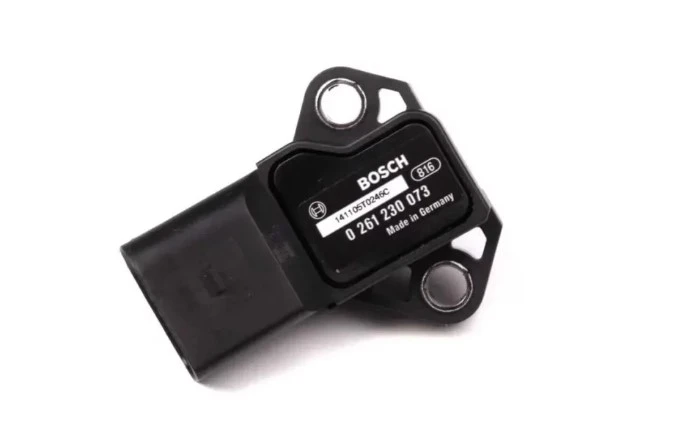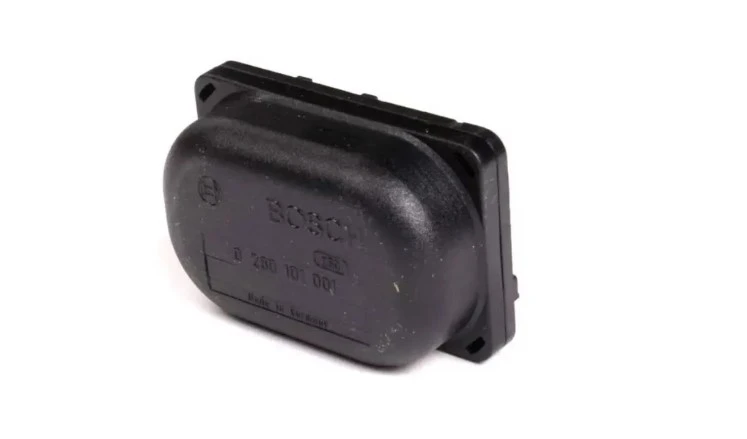Whether you live at a higher altitude or you simply like to head for the mountains from time to time, barometric pressure is a major factor in vehicle performance. When the air becomes less oxygen-rich, your engines need to compensate for it.
Although manufacturers use different systems to get this done, the most common solution is the use of MAP or BARO sensors. These sensors monitor changes in atmospheric pressure and allow the ECU to change ignition and fuel injection timing based on it.
The check engine light code for when this system fails is usually the P0129 check engine light code. In this guide, we will show you the ins and outs of MAP/BARO sensors, simple-to-understand diagnostic methods, and the symptoms and causes of the P0129 trouble code.

BOSCH MAP sensor
What is the P0129 Code, and What Does It Mean?
The P0129 code stands for “Barometric Pressure Too Low.” Atmospheric pressure is the pressure outside of your engine’s vacuum. Air pressure decreases as altitude increases, so your engine needs to increase the amount of fuel and change spark timing to compensate for this.
Of course, most people will not find themselves in extreme high-altitude conditions to see the P0129 code. It’s more likely that a failure in this system is causing a false positive reading and the PCM is adjusting based on that.
Where Is the Barometric Pressure Sensor Located?
Most barometric pressure systems are different. Most modern vehicles opt for a MAP sensor integrated into the intake manifold, which monitors both barometric pressure and intake manifold pressure. However, if you have a separate BARO sensor, it will be on the firewall (a barrier between you and the engine) or on the engine’s side of the front fender.
How Does a Barometric Pressure Sensor Work?
BARO sensors use a silicone membrane that expands and contracts based on atmospheric changes. Any changes in curvature are converted to a voltage. The ECU detects these changes and adjusts timing and fuel injection accordingly. It is a fairly simple system that works rather well.
What Causes the P0129 Code?
Barometric pressure errors are somewhat unique in the sense that failure of other systems rarely triggers these codes. The cause will almost always be related to the MAP/BARO sensor. That said, here is a list of the most common causes that will trigger this type of error:
- Faulty BARO/MAP sensor
- Wiring harness failure
- Vacuum pressure issues
Faulty BARO/MAP Sensor
MAP and BARO sensors are fairly rudimentary in nature. Aside from that silicone diaphragm and the built-in chop, there really isn’t much else that can fail. However, these do fail, and for a variety of reasons. Sometimes it’s simply the operating conditions that will cause a MAP sensor to fail. Constant hot/cold temperature cycles can lead to internal damage.
However, a MAP or BARO sensor can also fail if debris finds its way to them through the input vacuum line. This is especially true for engines that deal with a considerable amount of carbon buildup in the intake system.
Wiring Harness Failure
Your wiring harness is the primary means of power delivery for any piece of electronics in your car, MAP and BARO sensors included. Any damage to the shielding, wires, or connector could lead to a voltage loss or a complete short. If any of this happens on the BARO/MAP wiring, you might get a P0129 code.
Vacuum Pressure Issues
Vacuum pressure is the air pressure within the closed system of the engine compared to the atmospheric pressure. A cracked intake manifold and/or loose hoses can cause vacuum pressure to be lost and the P0129 code.
What Are the Common Symptoms of P0129 Fault Code?
To efficiently identify the root cause of a problem, you need to look at the symptoms. Not only will this help you dial in on the problem area more accurately, but understanding the symptoms will also tell you whether you’re dealing with a single issue or several of them. The common symptoms of a P0129 code are:
- Check engine light
- Black exhaust smoke
- Excessive fuel consumption
- Slow power delivery
- Contaminated spark plugs
Check Engine Light
The check engine light is the first indicator that there is a problem with your vehicle and you need to diagnose it as soon as possible. Depending on the nature of the code, you may or may not be able to drive your vehicle. With P0129, you should be able to move the car, although it is highly recommended that you get it fixed as soon as possible.
Black Exhaust Smoke
One of the most common symptoms of a P0129 code is black smoke coming out of the exhaust. Black smoke usually means that your engine is burning a rich air-fuel mixture, and is struggling to efficiently combust all the extra fuel.
A faulty MAP or BARO sensor will send wrong readings to the ECU, which will attempt to compensate by making the air/fuel mix richer. At that point, the ECU is probably thinking that your engine is operating at a higher altitude where there isn’t much oxygen. In reality, it’s just your MAP/BARO sensor acting up.
Excessive Fuel Consumption
A rich fuel mixture means higher fuel consumption. Incidentally, people generally notice that their gas mileage has gone down before they register the black smoke coming out of the exhaust. If your car is suddenly consuming large amounts of fuel, it might be time to get the MAP/BARO checked out.
Slow Power Delivery
The P0129 code often causes a rich running condition. There is an ideal fuel-air ratio that is optimized for your engine. Changing this can cause jerky acceleration, reduced performance, and damage to your engine.
Contaminated Spark Plugs
Spark plugs can tell you a lot about your engine. If your car is running lean, you’ll find that your spark plugs are white and clean. If it’s running rich, the spark plugs will have soot on them. With that in mind, a rich-air fuel mixture (caused by MAP sensor failure) can cause the spark plugs to become contaminated and malfunction over time.
How to Diagnose and Fix the Cause of P0129 Code

BOSCH barometric pressure
Now that you know what to look for and what could be causing your problems, it’s time to diagnose the issue and attempt a fix. Let’s discuss some of the steps that will help you do this efficiently.
OBD-II Reader
Your engine control unit uses complex software and hardware to control and interact with all the sensors on your vehicle. The OBD-II system allows the ECU to log vehicle faults and you to be able to read those codes.
The very first step in diagnosing any kind of car issue that triggers a check engine light code is to run a complete scan of the vehicle. Not only is that the only way to actually find out what you’re detailing, but it will also give you a more complete picture of the potential cause. Seeing one code and seeing several active codes will lead you down different diagnostic paths.
Visual Inspection
Inspecting your engine bay is vital to identify problem areas and potential failure points. First, you need to look at the MAP/BARO sensor for damage. Look for any corrosion on the sensor connector or any signs of extreme temperature damage that usually manifests in the form of melted plastics. Lastly, look for mechanical damage.
Any exposed wiring or breaks in the wiring harness can result in a P0129 code. It’s often that wiring harnesses fail internally, so ruling out external damage does not rule out the potential failure of the wiring harness.
Of course, a vacuum failure is also a common cause of the P0129 trouble code. Check for any loose or cracked hoses and damage to the intake or exhaust manifolds. Vacuum pressure issues are notoriously finicky to deal with, but if there is no visible damage in the engine bay, the issue is likely to originate somewhere else.
Wiring Harness Test
So, we’ve ruled out external damage to the wiring harness, but what about internal damage? You will need a multimeter to conduct this test as we will be testing whether the voltage is being carried to and from the sensor and grounding.
Depending on your vehicle, wiring configurations and voltage can differ slightly. You must check your owner’s manual wiring diagram before conducting any invasive tests.
For this test, we will be back probing the MAP sensor. Turn your ignition to the “on” position and contact the red multimeter probe with the positive wire and the black probe with the vehicle’s chassis, which we will be using for the ground.
The positive wire should give you around 12V, the signal wire should be around 1V, and the ground should show 0V.
BARO/MAP Sensor Test
Now that we’ve ruled out wiring harness failure, we need to test whether the sensor itself is working.
Start your vehicle. Take your red multimeter probe and contact the signal wire. The black probe should always contact the ground.
Your multimeter reading should be around 1V and rise as the engine rpm increases. The specific voltage on idle is not as important as the voltage increasing along with the engine rpm and there being some sort of initial voltage.
An oscilloscope is also great for identifying whether a sensor works properly. Connect your oscilloscope in the same way you connected the multimeter. The waveform should be square and the frequency on idle should be around 150Hz (i.e the waves should be close together). As the rpm increases, the frequency should decrease.
Vacuum Pressure Test
A lack of vacuum pressure is an indicator of the P0129 code. You will need a vacuum pressure gauge for this test. Connect your pressure gauge to the intake and start the vehicle. The pressure should be around 14HG to 22HG.
How to Fix the P0129 Code?
Fixing a P0129 code usually comes down to replacing the MAP or BARO sensors. These are not serviceable items so don’t count on being able to repair them. Sometimes blowing out a MAP can help if carbon buildup from the intake has caused an obstruction in the vacuum line. However, such instances are extremely rare.
Does P0129 Clear Itself?
This code is one that will clear itself once the pressure readings return to their normal range. You need to take your vehicle through a drive cycle or two before it clears. A quicker solution is to use an OBD-II reader to clear the P0129 trouble code.
Is It OK to Drive with P0129?
A rich-air fuel mixture can have serious consequences for the longevity of your engine. In the short term, you will not damage anything by driving with the P0129 trouble code. However, a rich fuel mixture can clog up your catalytic converter, which can turn out to be quite an expensive fix.
Fix the P0129 Code Using Quality Auto Parts!
Ordering the parts that you need doesn’t have to be difficult. That’s why at eEuroparts.com, we’ve built our website around the user. Our dropdown list allows you to pick your vehicle and takes you to a comprehensive list of parts tailored to your specific car!

